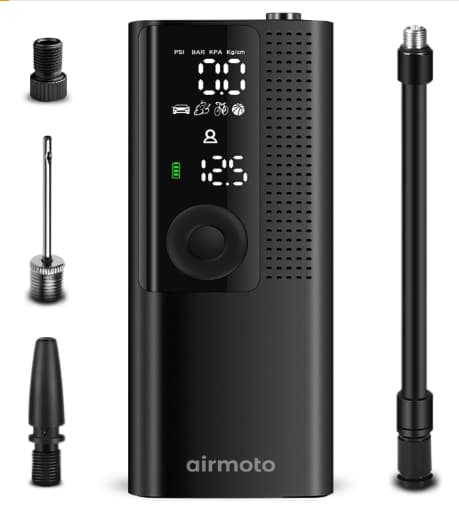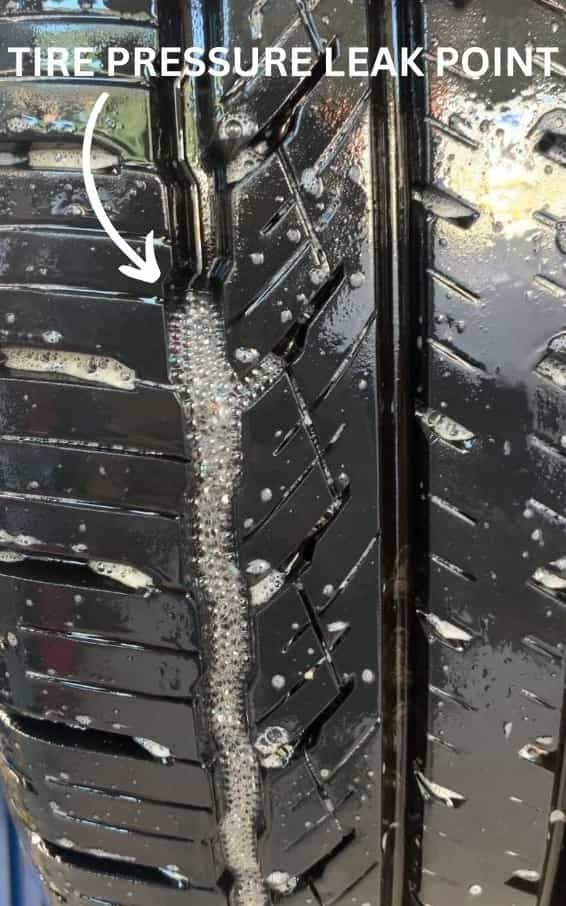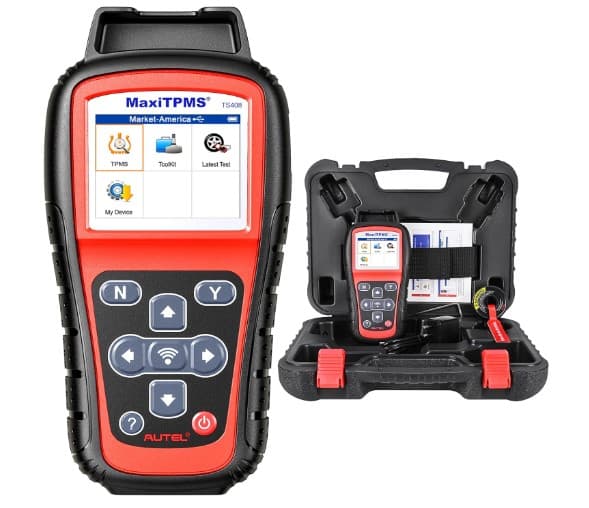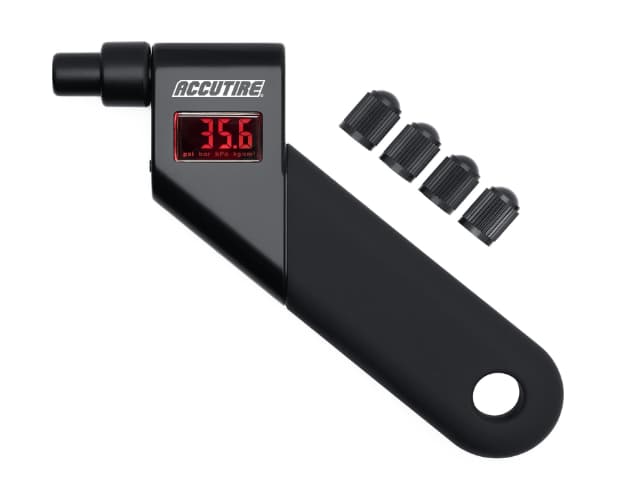What is the Chevy Traverse TPMS?
The Chevrolet Traverse incorporates a tire pressure monitoring system to prioritize your safety during commutes. It continuously checks the air pressure and temperature in every tire and relays this information on the vehicle’s display interface. Ensuring this feature functions flawlessly is key to the car’s performance and safety. The TPMS in the Chevrolet Traverse consists of tire pressure sensors, a TPMS data receiver module, the central vehicle computing system, and alerts for decreased tire pressure.
How Does the Chevy Traverse TPMS Work?
Chevrolet Traverse TPMS Sensors: Each Chevrolet Traverse tire contains a sensor, at the base of the valve stem. It monitors both the tire’s air pressure and its temperature. These sensors are made up of a circuit board, a transmitter, and a battery.
Data Sending Mechanism: The sensor’s transmitter employs radio waves to relay tire specifics to the Traverse’s onboard computer system.
Chevy Traverse Computer: The central computer, known as the ECM, assesses the incoming tire data against Chevrolet’s set guidelines for tire pressure and temperature.
Low Air Pressure Alert: When the tire’s air pressure falls below the desired level, a yellow alert light illuminates on the Traverse’s dashboard.
TPMS System Check: Should there be any issues or malfunctions with the Traverse’s tire pressure monitoring system, the dashboard alert light will start to flash.
Steps to Reset Chevy Traverse Tire Light
The Chevy Traverse does not have a dedicated TPMS reset button. Follow these steps to reset your tire pressure system:
Calibrate the air pressure of the Chevy Traverse tires in line with the advised measurements when the tires are in a cold state.
Drive the Chevrolet Traverse for a brief period while exceeding speeds of 25 Mph.
Steps to Relearn Chevy Traverse Tire Pressure Sensors
In cases of tire rotations, tire pressure sensor changes, or any tire-related services, proceed as follows:
Inflate every tire to approximately 40 Psi.
Turn the Chevrolet Traverse ignition to ON but keep the engine off.
Click on the Menu Button and direct yourself to the Vehicle Information Menu on the dashboard.
Use the scroll feature until the TIRE PRESSURE MENU comes into view.
While viewing the TIRE PRESSURE MENU, hold the SET/CLR button.
An alert will emerge, posing the question, “Are you sure that you want to relearn?“.
Confirm by selecting “Yes”.
A double horn sound will validate the action, displaying “TIRE LEARNING ACTIVE”.
Starting with the driver’s side front tire, deflate the tire until the horn chimes, and replicate for the other three tires in a clockwise direction. Front left, front right, rear right, rear left.
After hearing a horn beep after each successful tire relearning, the message on the information display will disappear.
Switch off the ignition and restore the pressure in all the tires to their optimal levels.
Drive the Chevy Traverse.
2023 Chevy Traverse Tire Pressure:
TIRE SIZE | FRONT PSI | REAR PSI |
255/65R18 | 35 | 35 |
255/65R20 | 35 | 35 |
What Triggers the Low Tire Pressure Warning in a Chevy Traverse?
Not maintaining optimal tire air pressure (either too low or too high)
Air loss
Missing tire sensors from wheels
TPMS sensor batteries that are dead or low
Electromagnetic disturbances
Changes in ambient air temperature or altitude variations
Exceeding the Chevy Traverse weight capacity
Attaching chains to tires
Windows tinted beyond recommended levels
Road surface temperature
Tires exhibiting holes, dry-rot, or bulges
Unmatched tire sizes
Software-related issues in the TPMS receiver module or the Chevrolet Traverse’s ECM
Broken tire pressure sensor during new tire installation
Leaking tire valve stem
Not resetting the tire pressure system
Chevy Traverse Tire Pressure Sensor Batteries
The Chevrolet Traverse uses four tire pressure sensors that have built-in batteries. These sensors, encased in black plastic, connect to the tire valves. Once their batteries drain, you can’t recharge or replace them; instead, you’ll have to get a new sensor. Chevrolet Traverse TPMS batteries generally last between 5 to 10 years or up to 150,000 miles of driving.
Diagnostic Steps for the Chevy Traverse Low Tire Pressure Light
If your Chevy Traverse’s tire pressure warning comes on, first attempt the standard TPMS reset. If this doesn’t solve the problem, use the TPMS relearn method. And if you’re still facing issues, the subsequent guidelines and some practical tests should aid in fixing the tire light.
STEP 1: DOES YOUR CHEVY TRAVERSE HAVE A TIRE AIR LEAK?
If you’re trying to see whether a tire leak is the culprit for the low pressure indicator, perform the Chevrolet Traverse TPMS reset procedure. A momentarily disappearing tire alert that reappears indicates the system is in order, but a tire may have a leak. On the other hand, a continuous warning light when all tires are inflated properly suggests a potential sensor issue.
STEP 2: FIND A TIRE LEAK USING SOAP AND WATER
To locate the potential air leak in your Chevy Traverse tire proceed as follows:
ESSENTIALS: Either an air compressor or a portable air pump, a sprayer bottle, some water, and liquid soap.
Fill the tire’s pressure to at least 35 Psi.
Formulate a lathery mixture combining water and your preferred liquid soap
Liberally spray the tire with this sudsy mix.
Examine the tire for any bubbles that might appear.
Should you detect bubbles, track their path to determine the leakage point.
STEP 3: HOW TO LOCATE A FAULTY TIRE SENSOR USING A TPMS PROGRAMMING DEVICE
Should you inflate all Chevrolet Traverse tires to the specified 35 Psi and still encounter a tire pressure alert, it’s possibly due to a tire pressure sensor with a low or dead battery. Assessing each sensor’s battery status requires either a TPMS programming tool or an OBD2 diagnostic scanner. Notably, the TPMS tool provides individualized checks of each sensor, while the OBD2 shares diagnostic codes that allude to the troubled tire. By adhering to the TPMS tools protocol, in-depth feedback on each sensor becomes available. If findings reveal battery concerns, erratic communication, or unexpected metrics (for instance, a tire temperature registering -91 degrees), that specific sensor demands a replacement.
STEP 4: RESET YOUR CHEVY TRAVERSE'S COMPUTER SYSTEM
When your Chevrolet Traverse’s low tire pressure alert goes off, it’s documented by the vehicle’s internal system as a diagnostic trouble code (DTC). The following is similar to resetting a computer that’s acting up. To go about it in your Chevy Traverse, here’s what you need to do:
Turn off both the engine and the electronic systems of the Chevrolet Traverse.
Carefully loosen and detach the negative connector from the Traverse’s 12 Volt battery.
Reconnect the negative connector back onto the 12 Volt battery and secure it tightly.
Engage in a consistent drive for an approximate 30 minutes, cruising at 50 Mph.
If the tire pressure alert deactivates and then reactivates during your journey, it’s likely pointing towards a tire pressure sensor’s dwindling battery or an actual dip in tire pressure.
STEP 5: DEALING WITH UNPEDICTABLE TIRE PRESSURE SENSORS IN A CHEVY TRAVERSE
Sometimes, tire pressure sensors can be unpredictable. For a Chevrolet Traverse, even when the tire is filled correctly and the pressure sensor battery is working, the low pressure warning might not turn off. This could be a sign that the Chevy Traverse tire pressure sensor is not active. To remedy this, consider these actions:
Lower the air in the targeted tire by a margin of 20 Psi. (this means if your pressure is currently at 45 psi, drop it to 25 psi, temporarily)
Afterwards, fill up the tire to its normal cold pressure and add 5 Psi extra. (So if the usual is 35 Psi, set it to 40 Psi.)
Take your Chevrolet Traverse for a drive lasting 10 minutes, maintaining speeds over 25 Mph.
Reset the air pressure back to the standard 35 Psi once the tires are cold again. .
Once more, drive the Chevy Traverse for a span of 10 minutes.
STEP 6: HOW A 10 DEGREE SHIFT CAN SET OFF THE CHEVY TRAVERSE'S TIRE LIGHT
The pressure in a tire is closely tied to external temperature shifts. A temperature swing of 10°F can mean a 1-2 psi change in tire pressure. Using the Chevrolet Traverse as an example: if it’s parked overnight at 68°F and the temperature descends to 41°F by the next morning, there could be a pressure drop of anywhere between 2-4 psi in its tires. This can be enough to trigger the Chevy Traverse low tire pressure light. Conversely, as temperatures soar or as tires are driven on, the air pressure will go up. This phenomenon occurs because of the behavior of air molecules, which condense in cooler environments and expand in hotter environments. It’s possible then, for the low tire notification on your Chevy Traverse to activate in cooler times and deactivate as tires get warmer with use. To prevent this from happening, ensure your Traverse tires are set to 35 Psi when they’re still cold and undriven for a few hours.
COMMON CHEVY TRAVERSE TIRE PRESSURE QUESTIONS
OPTIONS WHEN CHANGING CHEVY TRAVERSE RIMS, WHEELS, OR TIRES
Upon replacing the tires of your Chevrolet Traverse, adhere to the TPMS relearn steps. In case you change the Chevy Traverse’s rims/wheels, you have the option of repositioning the Chevy Traverse OEM tire pressure monitors from the former wheels to your new set before mounting the tires. After reattaching the wheels to the Traverse, follow the TPMS relearn routine.
ALTITUDE'S INFLUENCE ON THE CHEVY TRAVERSE'S TIRE PRESSURE
Driving your Chevrolet Traverse to higher altitudes? Remember, tire pressure adjusts with elevation. Data suggests that for every climb of 1,000 feet, there’s a growth of about 0.5 psi in tire pressure. So, a drive ascending to 6,000 feet could result in your Traverse’s tires gaining around 3 psi. This factor becomes particularly significant when monitoring tire health via the Traverse’s tire pressure monitoring system.
UNDERSTANDING THE IMPLICATIONS OF THE TIRE PRESSURE INDICATOR
For your safety, refrain from operating your Chevrolet Traverse if the low tire pressure alert is on. This indicator signals potential issues – either one or more tires may be underinflated, or there might be a problem with the tire pressure sensors. As a precaution, once you see the tire alert find a safe spot to stop, visually review the condition of each tire, and verify the air pressure using a gauge. Driving on underinflated tires is a hazard.
DURATION OF DRIVING WITH THE CHEVROLET TRAVERSE'S TIRE PRESSURE WARNING ON
There isn’t a standard measure of time or mileage to guide how long you can operate your Chevrolet Traverse with the tire pressure warning engaged. To understand how far or how long you can proceed with the TPMS indicator lit, it’s essential to diagnose the exact cause of the alert.
WHAT DOES IT MEAN WHEN THE CHEVY TRAVERSE TIRE LIGHT IS FLASHING?
Should you notice the Chevrolet Traverse low tire pressure light flashing, it’s indicative of a TPMS malfunction. This typically signals a communication error between a tire pressure sensor and either the ECM or the TPMS receiver module of the Traverse. It’s worth noting that the vehicle has this in-built self-assessment mechanism for such instances. A low or exhausted battery in a tire pressure sensor, or a wheel without a sensor (like the spare tire), could lead to a TPMS malfunctioning.
TIRE TREAD WEAR AND PLUG EFFECTIVENESS
Tire plugs are designed solely for fixing punctures on the tire tread. They are not suitable for the sidewall or for tires with completely worn treads.
WHAT ARE THE IMPACTS OF TIRE SEALANTS ON TPMS SENSORS?
Be cautious when injecting tire sealants like Slime or Fix-a-flat, as they may harm the tire pressure sensor’s electronics. Subsequently, evaluate the performance of the Chevrolet Traverse TPMS sensor after using.
Everything in this article is applicable to all Chevrolet Traverse models and versions including the Chevrolet Traverse LS, LT Cloth, RS, LT Leather, Premier, and High Country.
Please note that this blog post contains Amazon affiliate links. This means that if you make a purchase through one of these links, we at TPMSRESET.COM may earn a small commission at no extra cost to you. We only recommend products that we personally use and believe in. Thank you for supporting us.










